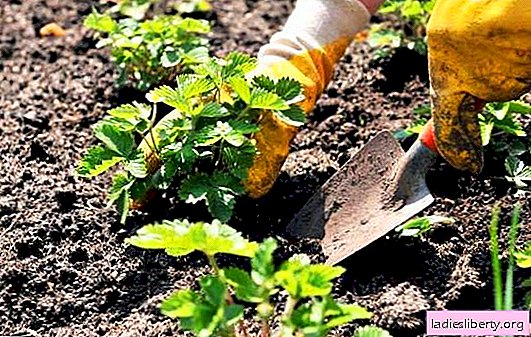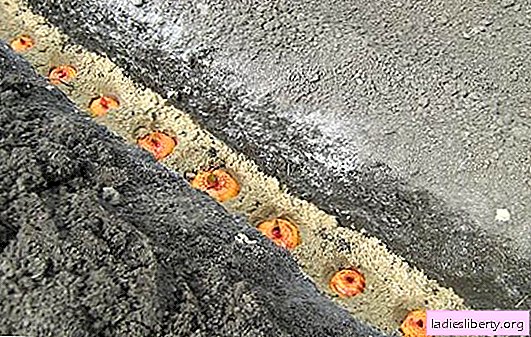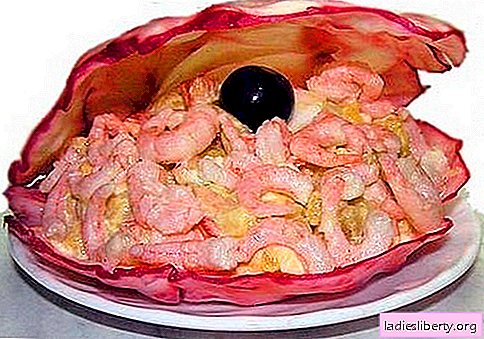
To wait for the full harvest of strawberries, as a well-deserved reward for all the labors, is the greatest pleasure for the gardener.
However, observing the bushes covered with berries, well-groomed bushes, an experienced gardener already knows that it is time to start all over again.
The most abundant fruiting occurs in the second and third year after planting.
Then the bushes give fewer berries, they become small, lose varietal characters, "degenerate."
To maintain yield, planting should be rejuvenated regularly, every 3-4 years. The best way to do this is to drop strawberries in a new place in the fall. Why fall?
Transplant strawberries. Autumn or spring?
Why do experienced gardeners prefer the autumn strawberry transplant, despite the danger of freezing seedlings? It would seem that in the spring it is waiting for much less surprises. There are several reasons for this:
1. The abundance of planting material. After the end of the berry season, strawberries grow rapidly in bushes, and many mustaches are formed.
2. The possibility of rooting at the optimum temperature and humidity. The heat receded, and the cold was still far away. Bushes are best rooted at temperatures up to +20 ° C.
3. Even if the wintering is unsuccessful, in the spring you can always plant plants in the place of the dead.
4. Successfully wintered bushes will yield in the summer. When planting in spring, full fruiting can be expected only in the second year.
The question remains - to transplant strawberries in August or autumn? The climate of the middle lane changes every year, prolonging the warmth and pushing back the dates of the first frosts. Therefore, strawberries planted in September have enough time to prepare for winter.
The shorter daylight hours stimulate the growth of the root system, rather than a lush bouquet of leaves. The developed root will easily tolerate winter cold, give a beautiful bush in the spring and a plentiful harvest in the summer. For rooting, a healthy bush is enough for three weeks. Therefore, September provides optimal conditions for the development of young strawberry bushes.
The choice of seedlings for transplanting strawberries in the fall, photo
In August, the fruit of the strawberries begins to grow leaves, the root, and throws away a lot of mustaches with young rosettes. It's time to select planting material for the new beds. For propagation by dividing the bush, choose 2 summer plants. Older specimens will not work, it is better to take seedlings from them grown from a mustache.
A mustache can take root in a bed next to a mother plant. But many gardeners root rosettes in separate containers, it is convenient for subsequent transplantation of strawberries in the fall or growing in the winter.

When 4-5 leaves appear, the rosette can be considered an independent plant and separated from the mother bush. Before planting, 3-4 young leaves are left on such seedlings, the rest are removed. So the root is easier to cope with the nutrition of the aerial parts, the plant will develop harmoniously.
It is necessary to ensure that only the first and second whiskers from each bush take root. All subsequent mustaches can be removed: they deplete the bush, the plants grown from them will be smaller, weaker. With abundant watering, the sockets manage to increase the developed root system by September, which will ensure their quick adaptation in a new place.
Soil preparation for autumn strawberry transplant
The soil must be prepared in advance. But in practice, you often have to quickly prepare a site that is freed from other crops. After tomatoes, potatoes, cucumbers, cabbage, it is not recommended to plant strawberries. The land after them is exhausted, needs to be restored. These crops have common pests, diseases.
The best predecessors for garden strawberries:
• legumes: after them, the earth is saturated with phosphorus, nitrogen;
• onions, garlic: no common pests, the earth is not infected;
• green manure is the best option: the soil has rested, and weeds are absent.
The site is dug, while applying organic and complex mineral fertilizers. For 1 square. m will require up to 3 kg of manure, about 100 g of superphosphate, the same amount of potash fertilizers.
Attention! Excess nitrogen during the autumn transplant causes increased growth of leaf mass, plants do not have time to prepare for wintering, they often freeze out. Nitrogen fertilizers (urea, nitrate) should not be applied during this period.
After digging, you need to let the land settle until September, covering it with agrofiber or mulching with straw. This will reduce weed growth, keep the bed loose and moist. In such conditions, beneficial microorganisms multiply well, the earth is restored faster.
The process of planting young bushes
The soil is prepared and seedlings are grown. It's time to start forming a new plantation. Each gardener has a favorite planting scheme:
• plantations with a continuous carpet;
• ribbons on several lines;
• staggered.
The main thing, with any method, to observe the distance between the bushes at least 25 cm, the aisles between the beds from 50 cm. The rules for replanting strawberry bushes in the fall (pictured) are the same for any season.

A cloudy day is chosen for work, or planting will have to be temporarily shaded. Dug holes well spilled with water, transfer to them young plants with a lump of earth. Having fallen asleep with the earth, they spill the bed again.
Note! It is better to remove the selected seedlings from a glass or dig out from the beds immediately before planting. If all the manipulations with the bush are done in an hour without damaging the roots, then the bush will not fade, the adaptation process will pass unnoticed, the plant will immediately begin to develop.
In a few hours, when the soil settles, it will be possible to verify the correct planting, sprinkle the soil under the bushes with dry peat or fertile soil. The root system develops well under cover materials or a layer of mulch (sawdust, straw, needles).
For the development of the root system you need the right watering. The soil should always be moist, but water stagnation is unacceptable. Cool nights, waterlogged soil contribute to root decay and the appearance of diseases. In autumn, sprinkling is replaced by root irrigation, drip irrigation.
Techniques that increase the survival rate of strawberries during transplanting in the fall
Mulching needles for the winter allows the roots to breathe, saves from frost, reduces the risk of gray rot disease, does not acidify the soil (unlike sawdust). Needles do not attract rodents and pests, this compares favorably with straw.
Landing under agrofibre or other covering material simultaneously performs several useful functions:
• suppresses weeds;
• maintains friability of the earth;
• reduces autumn temperature differences in the upper layers of the soil;
• protects the root system from freezing in winter.
A regular autumn strawberry transplant will save all varietal signs of your favorite berry. Planting rejuvenation, even on the same bed, preserves the yield, and a change of place will save strawberries from pests and diseases. With a careful housekeeping approach, you can get excellent berries for decades, without the need to buy and plant new seedlings. Your favorite variety can please you with abundant fruiting for many years. It all depends on patience and attention.











